Abstract
Oncogenic transformation is often accompanied by alterations of glycosylation on a tumor cell's surface, which may contribute to uncontrolled cell growth. The sialoglycans and degree of sialylation on the cell surface are of increasing interest because of their possible role in metastasis and tissue invasion. Since primary tumors and metastases may differ in the degree of sialylation, we examined the expression of sialic acid as a terminal constituent of lactosaminyl glycans on the cell surfaces of 30 cervical lymph-node metastases and 30 squamous-cell carcinomas of the oropharynx and oral cavity. Cell-surface sialylation was determined by a new histobiochemical assay on cryostat sections and was based on the enzymatic introduction of a fluorescence-labelled sialic acid into lactosaminyl type (Gal-β 1–4 G1cNAc) oligosaccharide chains of cell-surface-expressed glycoproteins. To this end, tissues were incubated in the presence of 5-acetamido-9-deoxy-9-fluoresceinyl-thioureido neuraminic acid (CMP-9-fluoresceinyl-NeuAc) and α-2,6-sialyltransferase. In order to compare the degree of sialylation with the potential total amount of sialylation sites, pretreatment with sialidase for desialylation was required. We observed a significantly higher amount of lactosaminyl-type binding sites for sialic acid on metastases compared to the primary tumors (P = 0.001), indicating a lower degree of sialylation in metastases. In primary tumors no correlation was seen between the amount of binding sites and tumor localization, TNM stage or histologic grading. Pretreatment of specimens with sialidase demonstrated a significant degree of sialylation on both primary tumors and lymph-node metastases, but no difference between primary tumors and metastases. When tumor stroma of primary tumors and metastases was compared, tumor cells showed a higher degree of free binding sites for sialic acid, but a low degree of sialylation. Our results suggest that differences in the degree of sialylation of glycoconjugates on a tumor cell's surface may play an important role in the process of cell metastasis. Our histobiochemical method turned out to be very reliable, effective and readily performed.
Similar content being viewed by others
References
Bollheimer LC, Schwartz-Albiez R, Sauer A, Gross HJ (1995) Enzymatic analysis of cell surface lactosaminyl glycans by flow cytometry. Biochem Biophys Res Commun 215:30–40
Collard JG, Schijven JF, Bikker A, La Riviere G, Bolscher JG, Roos E (1986) Cell surface sialic acid and the invasive and metastatic potential of T-cell hybridomas. Cancer Res 46: 3521–3527
Dennis JW, Laferte S, Waghorne C, Breitman ML, Kerbel RS (1987) Beta-1,6-branching of Asn-linked oligosaccharides is directly associated with metastasis. Science 236:582–585
Dobrossy L, Pavelic ZP, Bernacki RJ (1981) A correlation between cell surface sialyltransferase, sialic acid, and glycosidase activities and the implantability of B16 murine melanoma. Cancer Res 41:2262–2266
Fernandes B, Sagman U, Auger M, Demetrio M, Dennis JW (1991) Beta-1,6-branched oligosaccharides as a marker of tumor progression in human breast and colon neoplasia. Cancer Res 51:718–723
Fogel M, Altevogt P, Schirrmacher V (1983) Metastatic potential severely altered by changes in tumor cell adhesiveness and cell-surface sialylation. J Exp Med 157:371–376
Gottschalk A (1957) Neuraminidase: the specific enzyme of influenza virus and vibrio cholera. Biochim Biophys Acta 23: 645–646
Gross HG, B,nsch A, Paulson JC, Brossmer R (1987) Activation and transfer of novel synthetic 9-substituted sialic acids. Eur J Biochem 168: 595–602
Gross HJ, Sticher U, Brossmer R (1989) A highly sensitive fluorometric assay for sialyltransferase ctivity using CMP-9-fluoresceinly-NeuAc as donor. Anal Biochem 186:127–134
Hakomori S (1984) Tumor-associated carbohydrate antigens. Ann Rev Immunol 2:103–126
Hermanek P, Sobin LH (1987) UICC: TNM classification of malignant tumors, 4th edn. Springer, Berlin Heidelberg New York
Jiang M, Passaniti A, Penno MB, Hart GW (1992) Adrenal carcinoma tumor progression and penultimate cell surface oligosaccharides. Cancer Res 52:2222–2227
Kemmner W, Schlag P, Moller P, Brossmer R (1992) Homotypic aggregation and terminal glycosylation of cells from dissociated human colorectal tumor tissue. Oncology 49:63–67
Kobata A (1992) Structures and functions of the sugar chains of glycoproteins. Eur J Biochem 209:483–501
Muramatsu T (1993) Carbohydrate signals in metastasis and prognosis of human carcinomas. Glycobiology 3:291–296
Nicolson G (1982) Cancer metastasis - organ colonization and the cell-surface properties of malignant cells. Biochim Biophys Acta 695: 113–176
Passaniti A, Hart GW (1988) Cell surface sialylation and tumor metastasis. J Biol Chem 263:7591–7603
Poste G, Fidler IJ (1980) The pathogenesis of cancer metastasis. Nature 283:139–145
Roos E (1984) Cellular adhesion, invasion and metastasis. Biochim Biophys Acta 738:263–284
Singhal A, Hakomori S (1990) Molecular changes in carbohydrate antigens associated with cancer. Biossays 12:223–230
Smets L, Van Beek W (1984) Carbohydrates of the tumor cell surface. Biochim Biophys Acta 738:237–249
Steuer MK, Steuer M, Bonkowsky V, Strutz J, Gabius HJ, Hofstadter F (1995) Will neoadjuvant chemotherapy affect the capacity of head and neck squamous cell carcinomas to bind neoglycoproteins? ORL J Otorhinolaryngol Relat Spec 57:22–27
Sticher U, Gross HJ, Brossmer R (1991) Purification and characterization of α-2,6-sialyltransferase from human liver. Glycoconj J 8:45–54
Takano R, Muchmore E, Dennis JW (1994) Sialylation and malignant potential in tumor cell glycosylation mutants. Glycobiology 4:665–674
Van Beek WP, Smets LA, Emmelot P (1973) Increased sialic acid density in surface glycoprotein of transformed and malignant cells — a general phenomenon? Cancer Res 33:2913–2922
Varki A (1993) Biological role of oligosaccharides — all of the theories are correct. Glycobiology 3:97–130
Wolf GT, Carey TE, Schmaltz SP, McClatchey KD, Poore J, Glaser L, Hayashida D, Hsu S (1990) Altered antigen expression predicts outcome in squamous cell carcinoma of the head and neck. J Natl Cancer Inst 82:1566–1572
Yogeeswaran G (1983) Cell surface glycolipids and glycoproteins in malignant transformation. Adv Cancer Res 38:289–350
Yogeeswaran G, Salk PL (1981) Metastatic potential is positively correlated with cell surface sialylation of cultured murine tumor cell lines. Science 212:1514–1516
Author information
Authors and Affiliations
Rights and permissions
About this article
Cite this article
Bergler, W., Riedel, F., Schwartz-Albiez, R. et al. A new histobiochemical method to analyze sialylation on cell-surface glycoproteins of head and neck squamous-cell carcinomas. Eur Arch Otorhinolaryngol 254, 437–441 (1997). https://doi.org/10.1007/BF02439975
Received:
Accepted:
Issue Date:
DOI: https://doi.org/10.1007/BF02439975




